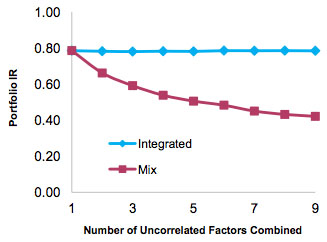Combining multiple factor exposures has already been shown to deliver higher returns and diversification. But how investors combine those factors can also make a tangible difference in a long-only portfolio’s performance, according to researchers at AQR.
Rather than just “mixing” factors—building separate standalone portfolios for each style and then combining those portfolios at the desired factor weights—investors should “integrate” factor exposures, argued Shaun Fitzgibbons, Jacques Friedman, Lukasz Pomorski, and Laura Serban.
“The integrated approach is a much more effective way to harvest long-only style premia,” they wrote.
 Source: “Long-Only Style Investing: Don’t Just Mix, Integrate”An “integrated” portfolio
differs from a “portfolio mix” in that assets are viewed through the lens of
multiple factors at the same time. For example, instead of creating separate
portfolios for value and momentum and combining the two, “integrated” investors
would build just one portfolio of assets that has been filtered for both value
and momentum.
Source: “Long-Only Style Investing: Don’t Just Mix, Integrate”An “integrated” portfolio
differs from a “portfolio mix” in that assets are viewed through the lens of
multiple factors at the same time. For example, instead of creating separate
portfolios for value and momentum and combining the two, “integrated” investors
would build just one portfolio of assets that has been filtered for both value
and momentum.
This way, the portfolio contains assets with “reasonably positive exposure to many styles rather than stocks with extreme positive exposure to one style that may simultaneously have extreme negative exposure to another style,” the authors explained.
For their study, Fitzgibbons, Friedman, Pomorski, and Serban constructed long-only multi-factor portfolios using both strategies. They found that integrated portfolios improved excess returns by 1% per year compared to mixed portfolios, while also increasing the information ratio by 40%. The more factors they combined, the more these benefits increased.
“Integrating styles in long-only portfolio construction has a first order effect on performance, generating benefits by avoiding stocks with offsetting style exposures and including stocks with balanced positive exposures,” they wrote.
While asset owners may prefer to hire different managers for different styles, or find it easier to monitor the performance of factors on an individual basis, the AQR researchers argued that such considerations “would need to be very important for investors to offset the direct performance benefits from integrating styles.”
“The integrated approach is likely to be meaningfully more attractive to investors,” they concluded.
